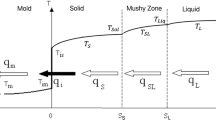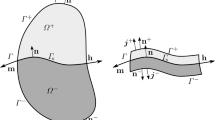Abstract
On the interface between a solid and a fluid, a reaction can occur in which atoms either leave the solid to join the fluid, or leave the fluid to join the solid. If the solid is in addition subject to a mechanical load, two outcomes may be expected. The reaction may proceed uniformly, so that the interface remains flat as the solid recedes or extends. Alternatively, the reaction may cause the interface to roughen and develop sharp cracks, leading to fracture. This paper reviews the current understanding of the subject. The solid-fluid is a thermodynamic system: the solid is in elastic equilibrium with the mechanical load, but not in chemical equilibrium with the fluid. Thermodynamic forces that drive the interfacial reaction include chemical energy difference between the solid and the fluid, elastic energy stored in the solid, and interfacial energy. The reaction is taken to be thermally activated. A kinetic law is adopted in which the stress affects both the activation energy and the driving force of the interface reaction. A linear perturbation analysis identifies the stability condition, which differs substantially from the well known stability condition based on the driving force alone. Large perturbations are examined by assuming that the interface varies as a family of cycloids, from slight waviness to sharp cracks. An analytic elasticity solution is used to compute the stress field in the solid, and a variational method to evolve the shape of the interface.
Similar content being viewed by others
References
W.W. Mullins, J. Appl. Phys. 30, 77 (1959).
D.J. Srolovitz, Acta Metall. 37, 621 (1989).
R.J. Asaro and W.A. Tiller, Metall. Trans. 3, 1789 (1972).
M.A. Grinfel'd, Sov. Phys. Dokl 31, 831 (1986).
C.-H. Chiu and H. Gao, Int. J. Solids Structures 30, 2981 (1993).
K.S. Kim, J.A. Hurtado, and H. Tan, Phys. Rev. Lett 83, 3872 (1999).
W.B. Hillig and R.J. Charles, in High Strength Materials, edited by V.F. Zackay (Wiley Inc., New York, 1965), p. 682.
T.-J. Chuang and E.R. Fuller, J. Am. Ceram. Soc. 75, 540 (1992).
M.J. Aziz, P.C. Sabin, and G.-Q. Lu, Phys. Rev. B 44, 9812 (1991).
W. Barvosa-Carter, M.J. Aziz, L.J. Gray, and T. Kaplan, Phys. Rev. Lett. 81, 1445 (1998).
Y.G. Shreter, D.V. Tarkhin, S.A. Khorev, and Y.T. Rebane, Phys. Solid State 41, 1295 (1999).
Z. Suo, Advances in Applied Mechanics 33, 193 (1997).
Z. Suo, Int. J. Solids Structures 37, 367 (2000).
C. Herring, in The Physics of Powder Metallurgy, edited by W.E. Kingston (McGraw-Hill Book Company, New York, 1951), p. 143.
S.P. Timoshenko and J.N. Goodier, Theory of Elasticity, 3rd edition (McGraw-Hill Book Co., New York, 1971).
H.H. Yu and Z. Suo, J. Appl. Phys. 87, 1211 (2000).
Z. Suo and H. Yu, Acta Mater. 45, 2235 (1997).
H.H. Yu and Z. Suo, Acta Mater. 47, 77 (1999).
Author information
Authors and Affiliations
Rights and permissions
About this article
Cite this article
Liang, J., Suo, Z. Stress-Assisted Reaction at a Solid-Fluid Interface. Interface Science 9, 93–104 (2001). https://doi.org/10.1023/A:1011283115948
Issue Date:
DOI: https://doi.org/10.1023/A:1011283115948




